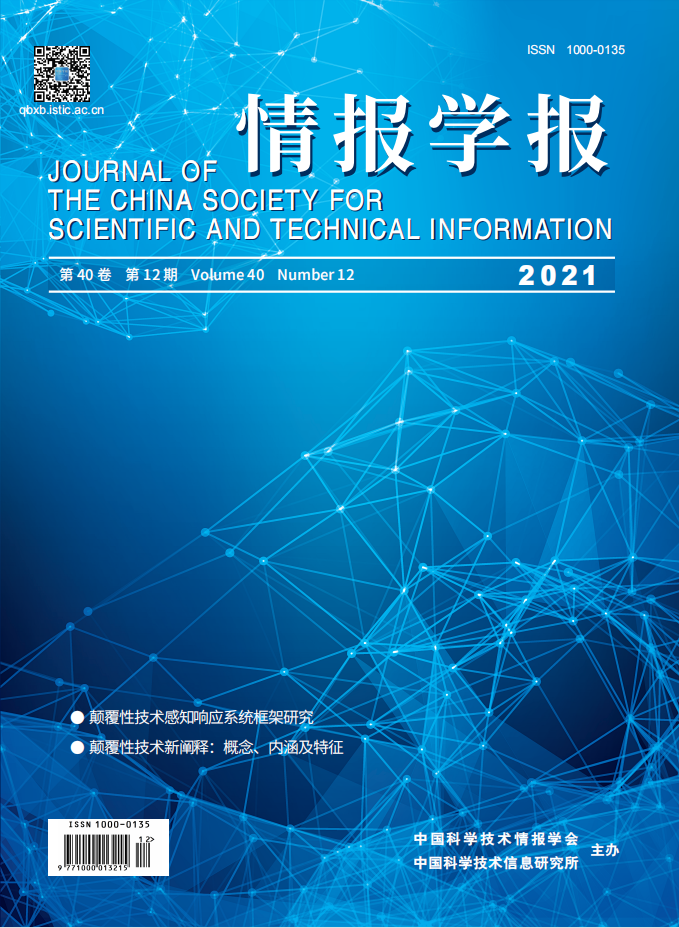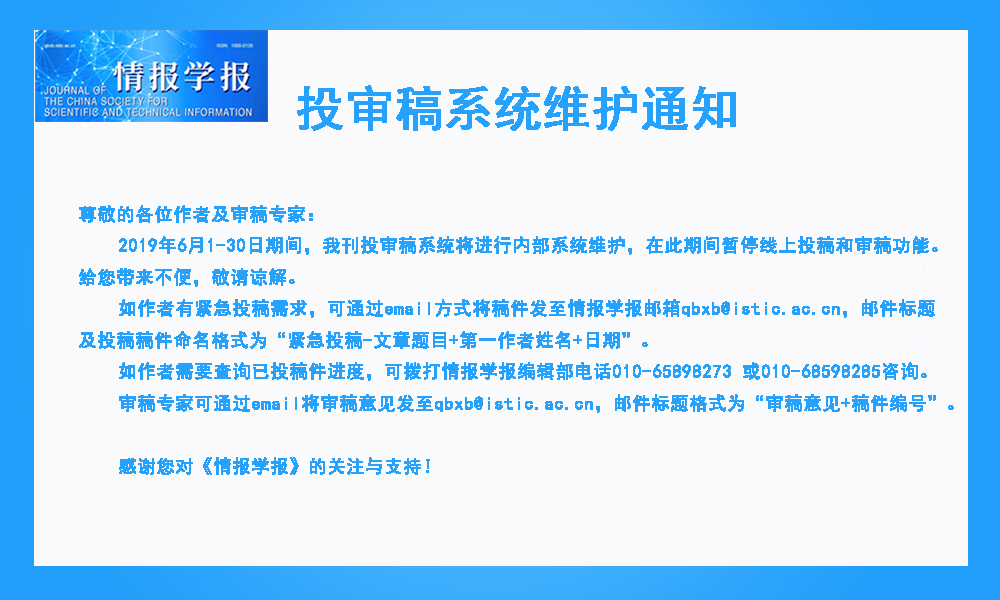 |
|
2021 Vol. 40, No. 12
Published: 2021-12-24 |
|
|
| |
|
|
|
|
|
1245 |
Research on the Framework of the Disruptive Technology Awareness and Response System Hot! |
|
 |
Zhao Zhiyun, Pan Yuntao, Su Cheng, Zhao Xiaoyuan |
|
|
DOI: 10.3772/j.issn.1000-0135.2021.12.001 |
|
|
This paper systematically reviews the research status in the field of disruptive technology, and summarizes the main problems of disruptive technology from the following three aspects: innovation theory, identification method and evaluation method. Considering the operability of the system, according to the principles of theoretical research, resource construction, common key technologies and application demonstration, we designed the framework of a four-part disruptive technology awareness and response system, consisting of a “disruptive technology identification theory and expert prediction system,” a “horizon scanning system,” an “innovative subject innovation awareness system,” and a “disruptive technology awareness and response platform development and decision support application,” to meet the need for subversive technology innovation management in China. This system framework enables the awareness and response to disruptive technologies, innovation subjects and policies, and can also provide services such as monitoring, identification, evaluation and response to disruptive technologies. At the same time, the system can effectively support the decision-making of national disruptive technologies and promote the innovation of disruptive technologies. |
|
|
2021 Vol. 40 (12): 1245-1252
[Abstract]
(
312
)
HTML
(74 KB)
PDF
(1789 KB)
(
373
) |
|
|
|
1253 |
New Explanation on Disruptive Technology: Concept, Connotation and Features Hot! |
|
 |
Su Cheng, Zhao Zhiyun, Zhao Xiaoyuan, Pan Yuntao, Jia Xiaoying |
|
|
DOI: 10.3772/j.issn.1000-0135.2021.12.002 |
|
|
At present, the academic understanding of the concept, connotation and features of disruptive technology is not clear enough, and there are still great differences in understanding. Based on this, this study focuses on the new interpretation of the concept, connotation and features of disruptive technology. By interpreting the state of development and analyzing the problems of existing concepts, connotations and features, the concept of disruptive technology is redefined in terms of means, methods, results and effects; the connotation of disruptive technology is newly interpreted in terms of technology sources, market characteristics, disruption processes and main driving forces, thus revealing the differentiated characteristics of different types of disruptive technology and the dynamic evolutionary characteristics of disruption; a new definition of the features of disruptive technology is provided, and five essential characteristics are proposed: “transformative,” “breakthrough,” “forward-looking,” “alternative,” and “high-risk;” and recommendations are made in terms of the funding system, priority development areas, and new management mechanisms of disruptive innovation funds. This study further clarifies a series of fundamental issues such as the basic concept, core connotation and essential features of disruptive technology, establishes the theoretical basis for better theoretical and practical work related to disruptive technology, and provides practical insights for promoting disruptive technology innovation in China. |
|
|
2021 Vol. 40 (12): 1253-1262
[Abstract]
(
569
)
HTML
(139 KB)
PDF
(745 KB)
(
650
) |
|
|
|
1271 |
Potential Disruptive Technology Assessment Method Based on Implicit Knowledge Hot! |
|
 |
Liu Zhihui, Zhang Junsheng, Lin Yi, Niu Beibei, Wang Lijun |
|
|
DOI: 10.3772/j.issn.1000-0135.2021.12.004 |
|
|
Bringing together the wisdom of experts and the public, i.e., implicit knowledge, for potential disruptive technology assessment is the trend in disruptive technology prediction. Generally, the accuracy of experts' predictions of disruptive technology is high, but there is also a risk of inaccurate or omitted predictions due to experts' cognitive bias and thinking set. Public participation in prediction helps to increase the diversity and novelty of disruptive prediction technology, and also helps to strengthen the comprehensiveness of prediction results. To gather the wisdom of experts and the public for predicting potential disruptive technologies, this paper studies the improvement of the method and mechanism of the prediction market for disruptive technology prediction, introduces the design and R&D results of the potential disruptive technology evaluation support system that gathers the wisdom of experts and the public, and puts forward suggestions for future work. |
|
|
2021 Vol. 40 (12): 1271-1278
[Abstract]
(
176
)
HTML
(65 KB)
PDF
(1935 KB)
(
173
) |
|
|
|
1294 |
Information Web-Sources for Intelligence Studies on Disruptive Technology Hot! |
|
 |
Li Mandi, Su Cheng, Cui Yiwen, Zhao Zhiyuan, Zhao Xiaoyuan |
|
|
DOI: 10.3772/j.issn.1000-0135.2021.12.007 |
|
|
In the era of big data, network information contains a lot of high-value information needed for disruptive technology identification. At present, the methods for identifying disruptive technologies are mainly expert evaluation and literature analysis. Mining weak signals of technological development from massive network information will provide effective data supplement for current methods. This paper analyzes the distribution of scientific and technological information resources in the network from the three perspectives of information organization form, innovation subject participation, and process of scientific activities; it then summarizes the characteristics of web-sources oriented to the collection of disruptive technology intelligence, establishes the selection framework of web-sources, and formulates the evaluation standards and procedures applicable to web-sources. Finally,a special intelligence collection system based on key web-sources is designed to provide important data support for the effective identification of disruptive technologies. |
|
|
2021 Vol. 40 (12): 1294-1300
[Abstract]
(
298
)
HTML
(67 KB)
PDF
(1065 KB)
(
200
) |
|
|
|
1301 |
Contrastive Analysis on Expired Patents' National Differences and Bibliometric Characteristics Hot! |
|
 |
Li Rui, Zhang Handong |
|
|
DOI: 10.3772/j.issn.1000-0135.2021.12.008 |
|
|
Expired patents are high-value patents with technology that is nearly unsurpassable and whose market share is difficult to plunder. Among the patents authorized by the National Intellectual Property Administration of China, the expiration rate of invention patents from patentees in Japan, the United States, Germany, France, and other countries is much higher than that of invention patents from Chinese patentees. In this paper, a nonparametric test method is used to analyze the national differences of expired patents' bibliometric characteristics. We then further track and compare invention patents in a specific field at three time windows (20 years ago, 10 years ago, and 5 years ago). The following results are shown. First, there is no positive correlation between expiration rate and citation level. The overall citation level of Chinese patents is higher, but the expiration rate is lower. Second, there is a significant positive correlation between expiration rate and citations. Third, the functional richness and universality of patents are important factors that affect their expiration rate. Fourth, the number of citing non-patent documents does not objectively reflect the degree of scientific association and has no influence on the patents' expiration rate. Finally, the size of the patent family is an important factor that affects whether a patent can be maintained until its expiration. |
|
|
2021 Vol. 40 (12): 1301-1311
[Abstract]
(
264
)
HTML
(111 KB)
PDF
(1846 KB)
(
139
) |
|
|
|
1312 |
Identifying Key Nodes via a Geographical Research Dominance Network: A Case Study of the Pharmaceutical Field Hot! |
|
 |
He Chaocheng, Wu Jiang, Liu Fuzhen, Wang Chunying |
|
|
DOI: 10.3772/j.issn.1000-0135.2021.12.009 |
|
|
The globalization of science has realized global-scale flows and optimized the allocation of research resources with a spatially uneven distribution. It is noteworthy that scientific collaboration plays a key role in the globalization of science. In particular, long-distance research collaboration, even cross-border collaboration, greatly promotes the creation and dissemination of knowledge as well as skills. However, the existing literature has the following two main limitations. First, it ignores the spatial features of research entities in a collaboration network, even though spatial features are important for the efficiency and quality of research collaboration. Second, the existing literature does not consider the dominance in research collaboration, even though research dominance is critical for the initiation, promotion, and output of research collaboration. To address these issues, we conducted a comprehensive spatial analysis on global-scale research dominance in the field of pharmaceutical science, leveraging co-publication data between 2010 and 2018 from the Web of Science Core Citation Database. We further proposed “GeoLeaderRank,” incorporating topological and spatial features of the research dominance network, to rank institutions. Finally, we validated the proposed GeoLeaderRank by citation counts and hg-index and compared it with the baseline metrics of traditional indices. The spatial analysis indicates that global research dominance is increasingly spatially clustering; research leadership in Eastern countries is becoming more prominent, and the pattern of long-distance and cross-border research dominance remains unaltered. The comparison between GeoLeaderRank and other traditional indices shows that GeoLeaderRank outperforms other baseline metrics in identifying institutions with high academic influence. Although some Chinese institutions are comparable to the top institutions in Europe and the United States in terms of traditional indices, they are not comparable to those peers in terms of citations, hg-index, and GeoLeaderRank. This paper sheds light on the spatial patterns and spatial biases of research dominance in research collaboration, which offers us new insights into research collaboration. |
|
|
2021 Vol. 40 (12): 1312-1324
[Abstract]
(
186
)
HTML
(198 KB)
PDF
(4746 KB)
(
103
) |
|
|
|
1325 |
Automatic Recognition and Bibliometric Analysis of Cited Books Hot! |
|
 |
Huang Shuiqing, Zhou Hao, Peng Qiuru, Wang Dongbo |
|
|
DOI: 10.3772/j.issn.1000-0135.2021.12.010 |
|
|
There are several citations of ancient books, which are called cited books. Present citation analysis focuses mostly on modern texts; the academic community pays less attention to the citation phenomenon in the texts of ancient books. In this paper, we apply the citation analysis method to ancient books and calculate and analyze the citation indicators of cited books in order to establish a preliminary framework for the bibliometrics research of cited books. This article takes Lunyu Zhushu, Maoshi Zhengyi, and Chunqiu Zuozhuan Zhengyi in Notes of Thirteen Classics as the sample. First, citation items from ancient books are automatically recognized based on CRF (conditional random field), Bi-LSTM (bidirectional long short-term memory) and Bi-LSTM-CRF models and compared their extracted features. Then, the citation analysis method is used to calculate and analyze various citation measurement indexes of these three classic books in order to examine the knowledge correlation between ancient books and discuss the citation behavior of ancient scholars. The results show that the machine learning model applied to the automatic recognition of citation items has a good overall effect, the two deep learning models perform better, and there is an obvious gap between CRF models. Among the two deep learning models, the Bi-LSTM-CRF model is slightly better than the Bi-LSTM. The scale of cited books is affected by various factors, and the cited times of classic documents account for the highest proportion, especially the ritual documents in classic documents. In addition, the ancient people’s citation behavior was influenced by multiple factors such as the purpose of the book, the scholars’ knowledge background, and the difficulty of obtaining the cited documents. |
|
|
2021 Vol. 40 (12): 1325-1337
[Abstract]
(
229
)
HTML
(163 KB)
PDF
(2496 KB)
(
231
) |
|
|
|


